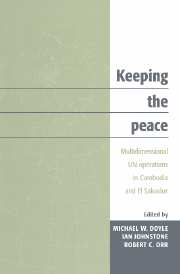Book contents
- Frontmatter
- Contents
- Preface
- Notes on the contributors
- List of abbreviations
- 1 Introduction
- Cambodia
- El Salvador
- Map
- 9 Insurrection and civil war in El Salvador
- 10 Peacemaking in El Salvador
- 11 The El Salvador Peace Accords: using international and domestic law norms to build peace
- 12 From peacekeeping to peacebuilding: restructuring military and police institutions in El Salvador
- 13 Rights and reconciliation in El Salvador
- 14 The arms-for-land deal in El Salvador
- Conclusion and chronologies
- Select bibliography
- Index
11 - The El Salvador Peace Accords: using international and domestic law norms to build peace
Published online by Cambridge University Press: 22 October 2009
- Frontmatter
- Contents
- Preface
- Notes on the contributors
- List of abbreviations
- 1 Introduction
- Cambodia
- El Salvador
- Map
- 9 Insurrection and civil war in El Salvador
- 10 Peacemaking in El Salvador
- 11 The El Salvador Peace Accords: using international and domestic law norms to build peace
- 12 From peacekeeping to peacebuilding: restructuring military and police institutions in El Salvador
- 13 Rights and reconciliation in El Salvador
- 14 The arms-for-land deal in El Salvador
- Conclusion and chronologies
- Select bibliography
- Index
Summary
Introduction
The El Salvador Peace Agreements (the Accords) represent an important step in carving out the new peacekeeping terrain between forcible intervention and respect for national sovereignty. The Accords mark the first time the government of a member state ceded to the international community a substantial role in reshaping its legal and institutional capacities. Unlike Cambodia, where the decades of civil war created a headless state, the El Salvador government, identifiable and in control, granted the United Nations an extensive mandate to assist in the reformation of its military, police, judiciary, and economy. This comprehensive mandate presents a potentially powerful model for how the international community can assist in bringing democracy, human rights, and peace to a member state before the ravages of war leave it ungovernable.
Under the UN Charter, the international community can only intervene in a narrow set of circumstances. Article 2(7) prohibits the UN from intervening on matters “essentially within the domestic jurisdiction” of a member state. The only exceptions are when there is a “threat to international peace and security” (chapter VII) or if the member state grants its “consent” (chapter VI). Historically, chapter VII has been invoked to halt armed attacks across borders and, most recently in Somalia and Rwanda, to alleviate humanitarian crises. Chapter VI, on the other hand, has been broadly interpreted to provide the legal mandate for peacekeeping missions (sometimes referred to as chapter VI 1/2), where two disputing parties consent to a UN presence in monitoring a ceasefire.
- Type
- Chapter
- Information
- Keeping the PeaceMultidimensional UN Operations in Cambodia and El Salvador, pp. 255 - 281Publisher: Cambridge University PressPrint publication year: 1997

